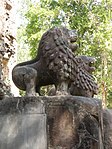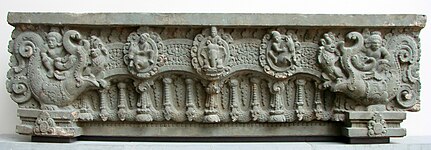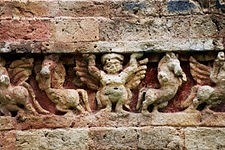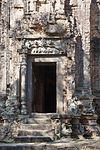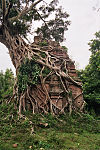Sambor Prei Kuk
សំបូរព្រៃគុហ៍ | |
Kampong Thom Province, Cambodia | |
| Region | Southeast Asia |
|---|---|
| Coordinates | 12°52′15″N 105°2′35″E / 12.87083°N 105.04306°E |
| History | |
| Builder | Isanavarman I |
| Founded | 7th century |
| Periods | Middle Ages |
| Site notes | |
Southeast Asia | |
Sambor Prei Kuk (Isanapura) (
Located on the Eastern bank of the
Clusters

The whole compound is made of three clusters classified as group C for Central, N for North and S for South (Michon & Kalay, 2012).[citation needed] They are enclosed in a double-walled encircling 1,000 acre in which there were 150 Hindu temples today mostly in ruins.
- Group N: Prasat Sambor (ប្រាសាទសំបូរ) is considered the main temple and it dates from the 7th century. It was dedicated to one of the reincarnations of Shiva known as Gambhireshvara (from Sanskrit गम्भीर - gambhir, profound, deep, solemn - and शिव, shvara, Shiva, Śiva, The Auspicious One).
- Group S: Prasat Yeah Puon (ប្រាសាទយាយព័ន្ធ) includes 22 sanctuaries dated from the 7th century (600 - 635 AD) during the reign of Isanavarman I in dedication to Shiva.[7]
- Group C: It is occupied by the Central Sanctuary or Prasat Boram (ប្រាសាទបុរាម) with lion sculptures that had inspired the popular name of Prasat Tao (The Lions' Temple). It is, however, the newest group dating the 9th century. The other main feature is the Tower of Ashram Issey, but there were also other constructions (18 temples) now in ruined (Palmer, 2011).[8]
History
7th century
The last important king in Isanapura was Jayavarman I, whose death caused turmoil to the kingdom at the start of the 8th century, breaking it in many principalities and opening the way to a new time: Angkor. This site is also claimed as an early capital of Jayavarman II (O'Reilly & Jacques, 1990).[13]
20th century
After the Lon Nol's coup d'état to Prince Norodom Sihanouk in 1970, US President Richard Nixon ordered a secret bombing of Cambodia to fight the Khmer Rouge guerrillas and any influence of North Vietnam in the country. The US aircraft bombed positions inside the archaeological site, causing craters near the temples, while the guerrillas left several mines on the land that were cleared only in 2008.
This site was added to the
Official religion
The official religion at Sambor Prei Kuk city was
Shaivism was the religion of Chenla (ca. 550 - ca. 800 AD), including elements of
Gallery
-
Group C and Prasat Boram or Prasat Tao.
-
Map of the Clusters.
-
The two lions at Prasat Boram.
-
Lintel from Sambo Prei Kuk at Guimet Museum, Paris.
-
Yeai Poeun Temple.
-
Temple N7.
-
Vajimukha (horse-headed deity) from temple N7 at the Guimet Museum.
-
Temple S1.
-
S1 Yeai Poeun Temple
-
Prasat Boram
-
Prasat Boram S1 Sanctuary. Sambor Prei Kuk.
-
Interior Temple S1.
-
Interior Temple S1.
-
Temple N18.
-
Temple N16.
See also
External links
- Beyond Angkor: Sambor Prei Kuk - Providing comprehensive list of associated sites of Sambor Prei Kuk, along with unique graphical interactive maps
- Visiting Sambor Prei Kuk - Detailed guide on how to visit the temples including a map
Notes
- ISBN 9786167339443
- ISBN 978-0-8248-0368-1.
- ^ "Sites in Cambodia, China and India added to UNESCO's World Heritage List". UNESCO. Retrieved 2017-07-08.
- ISBN 9780521275255.
- ^ Groupe de Sambor Prei Kuk - UNESCO World Heritage Centre
- ^ Gnarfgnarf:Sambor Prei Kuk : a pre-Angkorian gem in the forest, 20 November 2010, retrieved on 3 May 2012
- ^ Description Prasat Yeah Puon. Ministry of Tourism of Cambodia. Link retrieved on July 8, 2015 from http://www.tourismcambodia.org/provincial_guide/index.php?view=attdetail&prv=6&att=280
- ISBN 978-1-85828-837-6.
- ^ “Coedès. ‟Histories of Cambodia”. Page 11.
- ^ IC, Vol. V, p. 23
- ^ Wolters, "North-western Cambodia in the seventh century", p. 356 and pp. 374-375
- ^ Rinith Taing, “Was Cambodia home to Asia’s ancient ‘Land of Gold’?”, The Phnom Penh Post, 5 January, 2018.
- ^ O'Reilly. Early Civilizations of Southeast Asia. December 21, 2005. Page 113.
- ^ "Temple Zone of Sambor Prei Kuk, Archaeological Site of Ancient Ishanapura".
- ^ Hinduism: Beliefs and Practices, by Jeanne Fowler, pgs. 42–43
- ^ Mudaliyar, Sabaratna. "Lecture on the Shiva Linga". Malaysia Hindu Dharma Mamandram. Retrieved 27 March 2012.
- ISBN 0-691-01778-6. But the basic and most common object of worship in Shiva shrines is the phallus or lingam.
- ^ Chandler, A History of Cambodia, pp.19-20.



